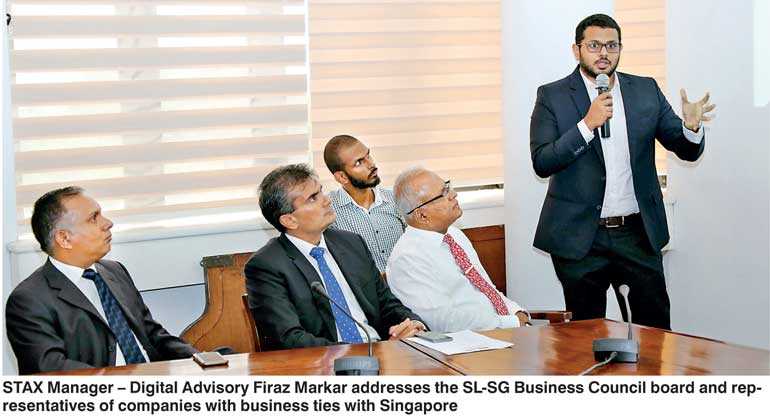Thursday Dec 12, 2024
Thursday Dec 12, 2024
Monday, 27 August 2018 01:06 - - {{hitsCtrl.values.hits}}

To raise awareness on current and future investment potential in Sri Lanka, leading management consulting firm STAX delivered a presentation on the SL-SG FTA and Foreign Direct Investment (FDI) dynamics and opportunities, at the recently concluded Annual General Meeting of the Sri Lanka-Singapore Business Council.
The meeting, which took place at the Ceylon Chamber of Commerce, was attended by the board of the SL-SG Business Council, together with representatives of companies maintaining business ties with Singapore.
Drawing on STAX’s extensive research capabilities and experience operating in the Singaporean market, Manager Firaz Markar presented an overall view of key challenges in investment, potential opportunities for investment and growth, and the significance of the SL-SG free trade agreement to council member companies.
“Singapore and Sri Lanka continue to share significant cultural and economic affinities, and over the past year, this relationship has manifested in increasing trade. Today, Singapore ranks as Sri Lanka’s 8th largest trading partner, and at present, there are over 90 Singaporean businesses – including major multinationals – that operate in the country, generating approximately 241 million dollars in investment in 2017.
Many of these companies choose to invest in Sri Lanka to take advantage of regional and relationship-driven benefits. Sri Lanka has the benefit of positive relationships with some of the largest economies in the Asian region, as well as access to trade routes and markets. However, while FDI has been improving over the recent past, we still attract investments at a much lower rate and scale than its regional counterparts.”
He further explained how most of Sri Lanka’s FDI had been generated through the telecommunication, manufacturing, and tourism sectors, while the IT sector had also shown improved potential with export growth of 18-19%.
Citing the results of a recent study carried out by STAX among foreign companies that have invested in Sri Lanka, he noted that the most pressing concerns for foreign investors remained a shortage of qualified labour, the high cost of setting up business, insufficient levels of productivity, and policy instability.
However, given the potential of Sri Lanka as a hub for regional trade, Firaz stated that a positive conclusion to the SL-SG FTA would serve as a signal for other nations to also enter into similarly liberal agreements with Sri Lanka to take advantage of reductions in tariff lines, labour movement and government procurement.
Such a transformation would enable Sri Lanka to serve as a gateway for global firms to gain access and negotiate deals with the ASEAN bloc, potentially expanding the scope of Sri Lanka’s economy by several orders of magnitude.
“Liberalisation of labour movement is of course a complex issue, but if policies stipulate that companies that have invested and set up businesses may be allowed, within specific criteria, to have some movement of labour, the Sri Lankan economy as a whole will benefit strongly,” Firaz stated.
He advocated for the establishment of a clearly defined and articulated national value proposition across industries, moving forward. This is in parallel to financial incentives geared to sustainably attract capital into key industries keeping with a portfolio approach to FDI. Ideally, all this would be managed under a single umbrella organisation tasked with setting and enforcing rules and guidelines.
In that regard, he noted that the 50% reduction in tariff lines – which will grow to 80% over the next 12-15 years – together with the first ever inclusion of government procurement will enable unprecedented opportunities for Sri Lankan businesses to compete for government contracts in Singapore. Similarly, it would incentivise Singaporean companies to engage in similar projects locally, enabling the country to benefit from the introduction of improved standards, international best practices and knowledge transfer opportunities.